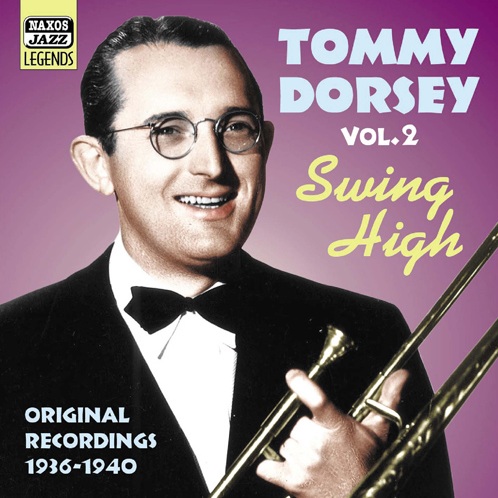Logowanie
KOLEKCJE!
BACH, CHOPIN, LISZT, MOZART, GRIEG, Dinu Lipatti, Otto Ackermann, Ernest Ansermet
The Master Pianist
PROKOFIEV, CHOPIN, TCHAIKOVSKY, SCHUMANN, BEETHOVEN, Martha Argerich, Claudio Abbado, Giuseppe Sinopoli
The Concerto Recordings
The Collection 2
Jakość LABORATORYJNA!
ORFF, Gundula Janowitz, Gerhard Stolze, Dietrich-Fischer Dieskau, Deutsche Oper Berlin, Eugen Jochum
Carmina Burana
ESOTERIC - NUMER JEDEN W ŚWIECIE AUDIOFILII I MELOMANÓW - SACD HYBR
Winylowy niezbędnik
ClearAudio
Essence MC
kumulacja zoptymalizowana: najlepsze z najważniejszych i najważniejsze z najlepszych cech przetworników Clearaudio
Direct-To-Disc
PIAZZOLLA, ChamberJam Europe
Tangos del Ángel y del Diablo
Direct-to-Disc ( D2D ) - Numbered Limited Edition
The Tommy Dorsey Orchestra
Swing High - Vol.2

- The Tommy Dorsey Orchestra - orchestra
Original Recordings 1936-1940
"Renowned now as then for the ‘liquid legato’ of his trombone playing, Tommy Dorsey was foremost among the Swing Era big-band leaders. Among the most prolific and best selling recording artists of the 20th century, he was also one of the most enduring, and successfully resurrected himself and his style with regular appearances on US TV in the mid-1950s. Thomas Francis Dorsey, younger brother of Jimmy (1904-1957), was born in Shenandoah, Philadelphia, on 19 November 1905. The boys played both trumpet and cornet in a family quartet comprising their coal miner-turned-bandmaster father, Tommy Snr. and sister Mary and formed their first orchestra ‘Dorsey’s Novelty Six — The Jazz Band Of Them All’ which later evolved into ‘Dorsey’s Wild Canaries’. They then disbanded and joined the Scranton Sirens, (one of the first American jazz groups to broadcast) and in 1925 worked with the Eddie Elkins Band and played and recorded with the California Ramblers. From 1924 Tommy and Jimmy were associated — touring and arranging — with the French-American pianist-bandleader Jean Goldkette (1899-1962), the new owner of the Greystone Ballroom in Detroit whose noted society band recorded for Victor. From 1925 onwards, Tommy worked regularly as a freelance sideman both in live venues and small-group recording sessions with, among others, Bix Beiderbecke, Ted Lewis, Red Nichols, Dave Rubinoff, Nat Shilkret, Frankie Trumbauer, Rudy Vallee, Joe Venuti and (during 1927-1928) Paul Whiteman. From 1932, with Jimmy, he made musical arrangements and organised studio ensembles and by 1934, on the Eve of the Swing Era, their own orchestra (which from 1928 had recorded for the Columbia label and its subsidiaries and had often played for Bing Crosby) had become a full-time affair with drummer Ray McKinley, Glenn Miller and Tommy himself among its players. During a Glen Island Casino gig in 1935 the two had their famous quarrel: they split and went their separate ways to lead highly successful outfits each in his own right. Tommy took over the resident band of his old friend Joe Haymes at New York’s McAlpin Hotel and, enlisting a team of arrangers headed by Paul Weston (aka Wetstein, b.1912), carved out a highly individual, smooth-sounding jazz style which highlighted his own subtle but prominent trombone-playing — in respect of which he earned the appellation ‘The Sentimental Gentleman of Swing’. Among the many first-rate sidemen who passed through his ranks were trumpeters Bunny Berigan, Ziggy Elman, Pee Wee Erwin, Charlie Shavers, Charlie Spivak and Yank Lawson, tenor saxophonist Bud Freeman, clarinettist Buddy De Franco and drummers Buddy Rich and Dave Tough. Among Tommy’s first big hits were the US No.1s "The Music Goes ’Round and ’Round" (1935) and "Alone" (1936) and by 1937 he had clocked up his first million-selling No.1 with Marie (a revival of the 1928 ballad by Irving Berlin). As America’s most popular up-and-coming swing-band leader he looked set fair to eclipse Goodman in disc sales, although the feud between the two organisations, at least superficially real and unrelenting, was largely stage-managed and newspaper-generated as a marketing ploy to increase sales for both orchestras. As they shared the same booking agents and recorded for the same company their healthy rivalry was ripe for grand-scale commer-cial exploitation and indeed, in terms of figures, Dorsey appears to have had the edge over his rival, for between 1935 and late 1939, whereas out of Goodman’s fifty Top 10 hits entered in the US popular charts nine were No.1s and five were No.2s, Tommy made 60 entries in the Top 10, including thirteen No.1s and four No.2s. While never the hottest nor perhaps even the sweetest of the larger swing-bands, Tommy Dorsey’s Dixieland-inspired outfit benefited from some outstanding arrangements and, prior to the Glenn Miller big band, could boast an ensemble second to none. Whether contempo-rary hits or re-workings of more traditional jazz fare, the bulk of his pre-war recordings fall into the category of timeless swing classics. Tommy scored two US No.1s in 1935 and by 1936, after scoring two more, was ideally placed to exploit both the latest in standards and film-songs and to swing new life into such jazz and Tin Pan Alley back-catalogue items as Bob Carleton’s Ja Da (1918) and Earl Lebieg’s Sleep (1923). Dorsey’s landmarks during 1937 included a further five US No.1s and Who? (a No.5 revival of the hit from the 1925 Broadway show Sunny) and Twilight In Turkey (with this fine Dean Kincaide orchestration of an original piano solo by bandleader Raymond Scott, featured in the Oscar-nominated 20th Century Fox film Ali Baba Goes To Town, he scored a No.18), while the 1938 list included, apart from one No.1 and two No.2s, the No.3 hit ‘Boogie Woogie’ (probably the most frequently-aired of all Dorsey ‘instrumentals’ and, by 1941, his second Gold Disc), a No.7 with Says My Heart (a Burton Lane-Frank Loesser standard first heard in the 1938 Paramount musical comedy Cocoanut Grove) and a No.8 in this cover-version by the Clambake Seven and Edythe Wright of Harry Warren and Johnny Mercer’s You Must Have Been a Beautiful Baby (from the Warner musical comedy Hard To Get). Tommy was officially "reunited" with Jimmy for the 1947 United Artists biopic The Fabulous Dorseys and from this another jointly-run band was forged which lasted until Tommy’s death in Greenwich, Connecticut, on 26 November, 1956." Peter Dempsey, 2003

























